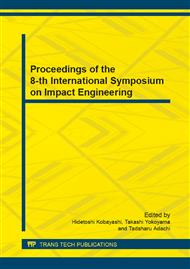[1]
T. Adachi, M. Kimura and S. Tada: Analysis on the preventive mechanism of landslide stabilizing piles, Numerical models in geomechanics, Elsevier, (1989), pp.691-698.
Google Scholar
[2]
C.Y. Chen and G.R. Martin: Soil-structure interaction for landslide stabilizing piles, Computers and Geotechnics, Vol. 29 (2002), pp.363-386.
DOI: 10.1016/s0266-352x(01)00035-0
Google Scholar
[3]
L.C. Reese: Fundamental concepts of pile design and analysis-P-y curves of lateral loaded piles, Pile Foundation (1994), 1-1-1-129.
Google Scholar
[4]
L.T. Chen and H.G. Poulos: Piles subjected to lateral soil movements, Journal of Geotechnical and Geoenvironmental Engineering, ASCE, Vol. 123 (1997), pp.802-811.
DOI: 10.1061/(asce)1090-0241(1997)123:9(802)
Google Scholar
[5]
G.R. Martin and C.Y. Chen: Response of piles due to lateral slope movement, Computers and Structures, Vol. 83 (2005), pp.588-598.
DOI: 10.1016/j.compstruc.2004.11.006
Google Scholar
[6]
M.J. Tomlinson and J. Woodward: Pile Design and Construction Practice, 5e, Routledge, (2008), ISBN 0415385822, 551pp.
Google Scholar
[7]
R. Rajapakse: Pile Design and Construction Rules of Thumb, Butterworth-Heinemann (2008), ISBN 0750687630, 416pp.
Google Scholar
[8]
K. Awoshika and L.C. Reese: Development of method of analysis of deep foundations supporting bridge bents, conducted by the Center for Highway Research for the Texas Highway Dept. and the Federal Highway Administration under the Cooperative highway research program. Bibliography, (1971).
DOI: 10.17226/24669
Google Scholar
[9]
K. Kubo: Experimental study of the behavior of laterally loaded piles, Proceedings of the 6th International Conference on Soil Mechanics and Foundation Engineering, Vol. 2 (1965), pp.275-279.
Google Scholar
[10]
N. Gerolymos, A. Giannakou, I. Anastasopoulos and G. Gazetas: Evidence of beneficial role of inclined piles: observations and summary of numerical analyses, Bull Earthquake Eng, Vol. 6 (2008), pp.705-722.
DOI: 10.1007/s10518-008-9085-2
Google Scholar
[11]
H.G. Poulos: Raked piles-virtues and drawbacks, Journal of Geotechnical and Geoenvironmental Engineering (ASCE), Vol. 132 (2006), pp.795-803.
DOI: 10.1061/(asce)1090-0241(2006)132:6(795)
Google Scholar
[12]
S.M. Prabha and A. Boominathan: 2012. Static and cyclic lateral response of battered piles in clay, Proceedings of the 7th International Conference on Physical Modelling in Geotechnics (ICPMG 2010), 28th June - 1st July, Zurich, Switzerland. Edited by Linda Seward CRC Press (2010).
DOI: 10.1201/b10554-164
Google Scholar
[13]
G. Ranjan, G. Ramasamy and R.P. Tyagi: Lateral response of batter piles and pile bents in clay, Indian Geotech. J., New Delhi, Vol. 10 (1980), pp.135-142.
Google Scholar
[14]
A. Trochanis, J. Bielak and P. Christiano: Simplified model for analysis of one or two piles. Journal of Geotechnical Engineering, Vol. 117 (1991), pp.448-466.
DOI: 10.1061/(asce)0733-9410(1991)117:3(448)
Google Scholar
[15]
C.H. Lim, Y.K. Chow and G.P. Karunaratne: Negative skin friction on single piles in a layered half-space, International Journal for Numerical and Analytical Methods in Geomechanics, Vol. 17 (1993), pp.625-645.
DOI: 10.1002/nag.1610170903
Google Scholar
[16]
Itasca Consulting Group Inc., FLAC3D, Fast Lagrangian analysis of continua in 3-dimensions, version 2. 0 manual, Itasca, Minnesota, (2005).
Google Scholar
[17]
J.G. Potyondy: Skin friction between various soils and construction materials, Geotechnique, Vol. 11 (1961), pp.339-353.
DOI: 10.1680/geot.1961.11.4.339
Google Scholar
[18]
Y.B. Acer, H.T. Durgunoglu and M.T. Yumay: Interface properties of sands, Geotechnical Division, Vol. 108 (1982), pp.648-654.
Google Scholar
[19]
S.S. Rajashree and T.G. Sitharam: Nonlinear finite-element modeling of batter piles under lateral load, Journal of Geotechnical and Geoenvironmental Engineering, Vol. 127 (2001), pp.604-612.
DOI: 10.1061/(asce)1090-0241(2001)127:7(604)
Google Scholar


